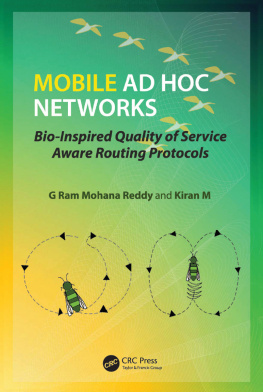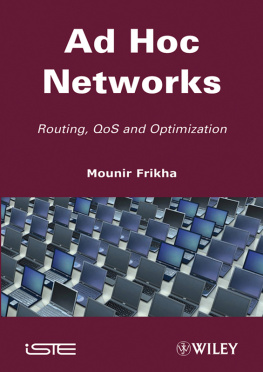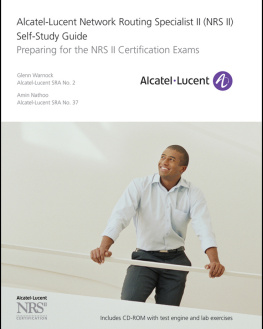Contents
Page List
Guide

MOBILE AD HOC NETWORKS
Bio-Inspired Quality of Service Aware Routing Protocols
MOBILE AD HOC NETWORKS
Bio-Inspired Quality of Service Aware Routing Protocols
G Ram Mohana Reddy Kiran M

CRC Press
Taylor & Francis Group
6000 Broken Sound Parkway NW, Suite 300
Boca Raton, FL 33487-2742
2017 by Taylor & Francis Group, LLC
CRC Press is an imprint of Taylor & Francis Group, an Informa business
No claim to original U.S. Government works
Printed on acid-free paper
Version Date: 20160614
International Standard Book Number-13: 978-1-4987-4685-4 (Hardback)
This book contains information obtained from authentic and highly regarded sources. Reasonable efforts have been made to publish reliable data and information, but the author and publisher cannot assume responsibility for the validity of all materials or the consequences of their use. The authors and publishers have attempted to trace the copyright holders of all material reproduced in this publication and apologize to copyright holders if permission to publish in this form has not been obtained. If any copyright material has not been acknowledged please write and let us know so we may rectify in any future reprint.
Except as permitted under U.S. Copyright Law, no part of this book may be reprinted, reproduced, transmitted, or utilized in any form by any electronic, mechanical, or other means, now known or hereafter invented, including photocopying, microfilming, and recording, or in any information storage or retrieval system, without written permission from the publishers.
For permission to photocopy or use material electronically from this work, please access www.copyright.com (http://www.copyright.com/) or contact the Copyright Clearance Center, Inc. (CCC), 222 Rosewood Drive, Danvers, MA 01923, 978-750-8400. CCC is a not-for-profit organization that provides licenses and registration for a variety of users. For organizations that have been granted a photocopy license by the CCC, a separate system of payment has been arranged.
Trademark Notice: Product or corporate names may be trademarks or registered trademarks, and are used only for identification and explanation without intent to infringe.
Visit the Taylor & Francis Web site at
http://www.taylorandfrancis.com
and the CRC Press Web site at
http://www.crcpress.com
To my parents, B. Manjappa and Padma Manjappa, my wife, Dr. Karishma Kiran, and my daughter, Manasvi Kiran.
Kiran M.
To my parents, the late Sri G. Ramasubba Reddy and the late Smt. G. Ramakka, and my elder brother, the late Sri G. Ramachandra Reddy.
G.R.M. Reddy
Contents
The distinguishing characteristics of mobile ad hoc networks (MANETs) such as increased connectivity, decentralized communication, infrastructure-less environment, easy deployment and maintenance have made MANETs a promising and popular network in todays telecommunication network. These distinguishing features of MANETs are well suited for military applications and disaster applications. Further, MANETs are also used in emergency operations such as search and rescue. Thus, this applicability of MANETs has further influenced its increased popularity among the other networks. Hence, MANETs have become research topics of high interest in research fields. On the other hand, MANETs suffer from the following shortcomings:
1. Due to multi-hop communication models, MANETs suffer from low throughput, high end-to-end delay and increased control packet overhead.
2. Due to the dynamic topology of MANETs, finding a reliable path between the source and the destination node is a challenging task.
3. As MANETs contain resource constrained nodes and channels are shared among the available nodes in the network, providing QoS to the application end users is difficult.
4. Since available bandwidth is smaller, providing quality of service (QoS) in MANETs is more difficult.
5. As communication channels are shared, there are some security issues in MANETs, especially in military applications.
Thus, researchers are working toward finding new and novel solutions to the weaknesses of MANETs. In recent years, a lot of work has been done in an effort to incorporate swarm intelligence (SI) techniques in building adaptive routing protocols for MANETs. As centralized approaches for routing in MANETs lack scalability and fault tolerance, SI techniques provide natural solutions through distributed approaches to the adaptive routing for MANETs. Further, the cross layer desing (CLD), a promising technique used for providing QoS, has not been explored much in developing SI-based routing protocols for increasing the efficiency of mobile wireless networks. One can find very limited work which combines CLD and SI techniques in developing adaptive routing protocols for MANETs.
Thus, this text concentrates on two different techniques, namely SI and CLD, for providing QoS in MANETs. Further, the authors focus on how security could be provided to the application end users through SI principles for MANETs. At the end of the day, reader will know about the salient features of animal societies and insect societies that have influenced researchers in developing adaptive routing protocols for MANETs and exploring the analogy between MANETs working principles and animal and insect societies. Further, the future directions will motivate the researchers to think in the open research directions in the fields of SI and CLD for providing QoS for MANETs.
I thank my parents, B. Manjappa and Padma Manjappa, for their constant encouragement. I attribute the completion of this work to the help of my wife Dr. Karishma Kiran, and my daughter, Manasvi Kiran. Without them, this text surely would not have been made possible. I also thank C.G.M Vishwas and Mamatha for their continuous support during the preparation of this text. Finally, I thank my institution, Jawaharlal Nehru National College of Engineering at Shivamogga, Karnataka, India.
M. Kiran
I express my sincere gratitude to the Directors of National Institute of Technology Karnataka Surathkal, Mangalore, Karnataka, India namely Prof. Sandeep Sancheti (during November 2006 to July 2012) and Prof. Swapan Bhattacharya (during August 2012 to December 2015) for their enthusiasm and support towards research in this area of Mobile Ad Hoc Networks and also for writing this book. I also thank my wife, Vijayalakshmi, for her patience and encouragement during the preparation of this book.
G.R.M. Reddy
CONTENTS
Computer networks can be broadly classified as wired and wireless networks. Wireless networks can be further classified into single-hop and multi-hop wireless networks. Single-hop wireless networks can be infrastructure based (e.g., cellular networks) or infrastructure-less (e.g., Bluetooth). Multi-hop wireless networks can also be infrastructure based (e.g. Wireless Mesh Networks WMNs) or infrastructure-less (e.g., mobile ad hoc networks (MANETs), or wireless sensor networks (WSNs)). Infrastructure-based networks have a fixed infrastructure of network elements such as routers, gateways, access points and base stations. Infrastructure-less networks do not have any fixed infrastructure and hence nodes act as routers or gateways when required. shows the general classification of computer networks.








